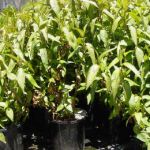| Common Name: |
Laksa Plant |
| Other Names: |
Asian mint, Hot Mint, Laksa Leaves, rau râm, Vietnamese Cilantro |
| Botanical Name: |
Persicaria odorata syn. Polygonum odoratum |
| Genus: |
Persicaria |
| Family: |
Polygonaceae |
| Location: |
SE Asia |
| Cultivation: |
Rich, moist soil in sun or partial shade. |
| Propagation: |
By seed sown in autumn or spring; by division in autumn or spring; by semi-ripe cuttings in summer, which root easily in soil or water. |
| Harvest: |
Rhizomes are lifted in autumn and dried for decoctions, infusions, liquid extracts, powders, and tinctures. Young leaves are picked as required and used fresh. |
| Height: |
45cm (18in) |
| :Width |
1.2m (4ft) |
Hardiness: |
Min. 7°C (45°F) |
| Parts Used: |
Leaves |
| Properties: |
A strongly aromatic herb that aid digestion and has anaphordisiac effects. |
| Medicinal Uses: |
Internally to improve digestion and depress sexual appetite. Externally for ringworm. |
| Culinary Uses: |
Cilantro-flavored young leaves are added to salads, meat dishes, (especially fowl), duck, eggs, and the sauerkraut-like du´a cân in Vietnamese cuisine. |
| Bibliography: |
Encylopedia of Herbs by Deni Brown Copyright ©: 1995, 2001 Dorling Kindersley Limited pg 309
|

